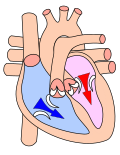Cardiac physiology or heart function is the study of healthy, unimpaired function of the heart: involving blood flow; myocardium structure; the electrical... 47 KB (5,784 words) - 11:54, 12 June 2023 |
 | refractory period. The refractory period in cardiac physiology is related to the ion currents that, in cardiac cells as in nerve cells, flow into and out... 11 KB (1,302 words) - 06:37, 23 March 2024 |
 | In cardiac physiology, cardiac output (CO), also known as heart output and often denoted by the symbols Q {\displaystyle Q} , Q ˙ {\displaystyle {\dot... 75 KB (9,349 words) - 11:09, 5 April 2024 |
separately, under the names cardiac physiology and circulatory physiology. Although the different aspects of cardiovascular physiology are closely interrelated... 6 KB (443 words) - 23:35, 22 October 2023 |
 | Cardiac muscle (also called heart muscle or myocardium) is one of three types of vertebrate muscle tissues, with the other two being skeletal muscle and... 42 KB (5,108 words) - 13:34, 28 April 2024 |
 | Wiggers diagram (category Cardiovascular physiology) in teaching cardiac physiology for more than a century. In the Wiggers diagram, the X-axis is used to plot time subdivided into the cardiac phases, while... 4 KB (298 words) - 14:33, 6 December 2023 |
 | Preload (cardiology) (category Cardiovascular physiology) In cardiac physiology, preload is the amount of sarcomere stretch experienced by cardiac muscle cells, called cardiomyocytes, at the end of ventricular... 6 KB (716 words) - 08:47, 4 February 2024 |
 | below) and is a fundamental step in cardiac excitation-contraction coupling. There are important physiological differences between the pacemaker cells... 46 KB (5,430 words) - 18:10, 24 April 2024 |
 | T wave (category Cardiac electrophysiology) depolarization and is negative current, signifying the relaxation of the cardiac muscle of the ventricles. But this negative flow causes a positive T wave;... 14 KB (1,763 words) - 13:05, 3 April 2024 |

